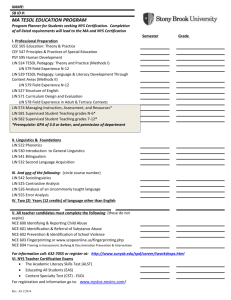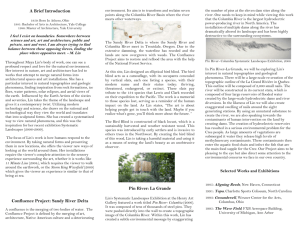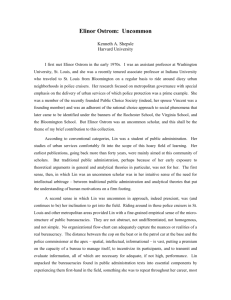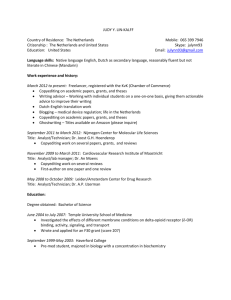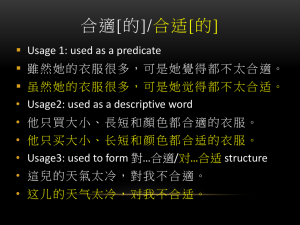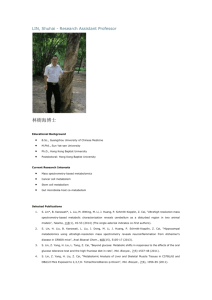2010-5-5-General-Systems-Theory-Jeffrey-Forrest - Aea
advertisement
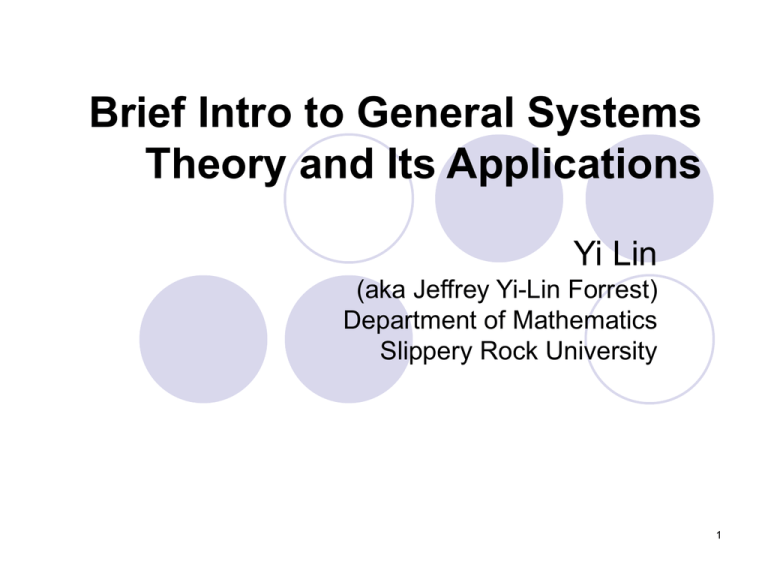
Brief Intro to General Systems Theory and Its Applications Yi Lin (aka Jeffrey Yi-Lin Forrest) Department of Mathematics Slippery Rock University 1 1. Systems Movement von Bertalanffy (1934) wrote: Since the fundamental character of living things is its organization, the customary investigation of individual parts and processes cannot provide a complete explanation of the phenomenon of life. This investigation gives us no information about the coordination of parts and processes. Thus the chief task of biology must be to discover the laws of biological systems (at all levels of organization). We believe that the attempts to find a foundation at this theoretical level point at fundamental changes in the world picture. This view, considered as a method of investigation, we call “organismic biology” and, as an attempt at an explanation, “the system theory of the organism.” 2 From this statement and seemingly unsolvable problems in practice, such as prediction of zero-probability disastrous weather conditions, we see the concept of systems was formally introduced. As tested in the past 90 some years, this concept has been widely accepted by the entire spectrum of science and technology 3 Some of historical milestones: 1948, Norbert Wiener’s paper: Cybernetics or Control and Communication in the Animal and the Machine. 1954, Ludwig von Bertalanffy, Anatol Rapoport, Ralph W. Gerard, Kenneth Boulding establish Society for the Advancement of General Systems Theory, in 1956 renamed to Society for General Systems Research. 1955, W. Ross Ashby’s work: Introduction to Cybernetics 1968, Ludwig von Bertalanffy’s work: General System theory: Foundations, Development, Applications 1988, the Society for General Systems Research is renamed as International Society for Systems Sciences. 4 Klir (2001): Systems thinking focuses on those properties of systems and associated problems that emanate from the general notion of systemhood, while the divisions of the classical science have been done largely on properties of thinghood, systems research naturally transcends all the disciplines of the classical science and becomes a force making the existing disciplinary boundaries totally irrelevant and superficial. 5 Cross-disciplinary feature of the systems research implies Researches of systems science can be applied to virtually all disciplines of the classical science; Issues involving systemhood, studied in individual specialization of the classical science, can be studied comprehensively and thoroughly; and A unifying influence on the classical science where a growing number of narrow disciplines is created. 6 So, the classical and systems sciences can be viewed as a genuine two-dimensional science. With the added advantage of the second dimension – the systems science, we (Lin, 2009; 2010) can show some important impacts of this second dimension on the first dimension – the classical science. 7 2. Basic Concepts Systems methodology: Quastler (1965): employs the concepts of a black box and a white box to show research problems (of the past) can be represented as white boxes, and their environments as black boxes. The objects of systems are classified into several categories … Through a set of rules, policies, and regulations, sensors and effectors do what they are supposed to do. 8 Zadeh (1962): important problems in systems science: Systems characteristics, systems classifications, systems identification, signal representation, signal classification, systems analysis, systems synthesis, systems control and programming, systems optimization, learning and adaptation, systems liability, stability, and controllability. Main task of systems science: general properties of systems without considering their physical specifics 9 Zadeh’s viewpoint: Systems science is an independent scientific endeavor whose job is to develop an abstract foundation with concepts and frames in order to study various behaviors of different kinds of systems. Therefore, systems science should be based on a theory of mathematical structures of systems with the purpose of studying the foundation of organizations and systems structures. 10 What is a system? As all concepts in science, ideas / thinking logic of systems have a long history. Chinese traditional medicine (~5,000 years) Aristotle’s “whole is greater than the sum of its parts” In modern times, new contents added to the ancient systems thinking 11 The methodology of studying systems as wholes agrees with the development trend of modern science, Where: divide the object of consideration into parts as small as possible and studying all of the individual parts, seek interactions and connections between phenomena, and to observe and comprehend more and bigger pictures of nature. 12 Concept of system is difficult if not impossible Klir (2001) defines a system as what is distinguished as a system. To establish a theory of general systems with applicable results, Lin (1987) introduces the following mathematical definition: S = (M, R) M: the set of objects of the system, R a set of relations of the objects. These relations in R make the system S appear. 13 3. The Geometric Intuition We need an extremely important tool: A common language and intuition which can be easily employed for everyone to think about systems, to manipulate abstract systems, and to implement conclusions about general systems to specific structures or organizations. 14 Why: Modern science, the 1st dimension, mostly makes use of numbers, quantities, and parametric dimensions on the intuitive background of Euclidean spaces, such as Cartesian coordinate systems. Because of this reason, modern science has brought forward its greatness. Here the common language: concept of numbers and its abstraction – quantities the common intuition: Euclidean spaces. 15 Intuition for general/abstract systems In 1990s, it is shown 1.Nonlinear evolution models = singularity problems of mathematical blown-ups of uneven formal evolutions 2. Nonlinear evolution models describe mutual reactions of uneven structures of materials That is, nonlinearity is no longer a problem of formal quantities. 16 On blown-up theory, the concepts of black holes, big bangs, and converging and diverging eddy motions are coined together (Wu and Lin, 2002): Figure 1.1. Eddy motion model of a general system 17 4. Application: The Rotten Kid Theorem Becker’s Rotten Kid Theorem (1974) If a family has a head who cares about all other members so much that he transfers his resources to them automatically, then any redistribution of the head’s income among members of the household would not affect the consumption of any member, as long as the head continues to contribute to all. Additionally, other members are also motivated to maximize the family income and consumption, even if their welfare depends on their own consumption alone. 18 Theorem (Lin & Forrest, 2008) Becker’s Rotten Kid Theorem holds true, if and only if the distribution of the benevolent head’s resources is not in conflict with the consumption preferences of any selfish member. Figure 10.3. Interactions between benevolent head H and a selfish kid K 19 Main references All materials presented here can be found in the following publications and references there: Lin, Y. (1999). General Systems Theory: A Mathematical Approach. New York: Kluwer Academic and Plenum Publishers. Lin, Y. (2008). Systemic Yoyos: Some Impacts of the Second Dimension. New York: Auerbach Publications, an imprint of Taylor and Francis. Lin, Y., and OuYang, S. C. (2010). Irregularities and Prediction of Major Disasters. New York: Auerbach Publications, an imprint of Taylor and Francis. 20 Thank You 21




